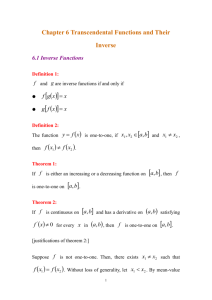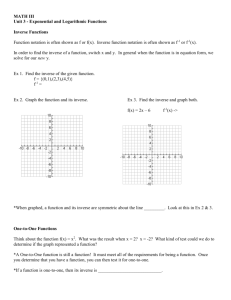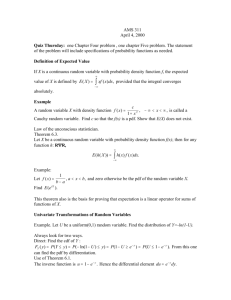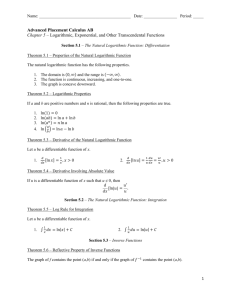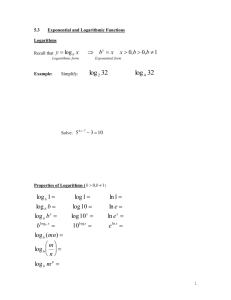Calculus Ch5 Review – Assignment p. 401 10,16,18,39,65 The
advertisement
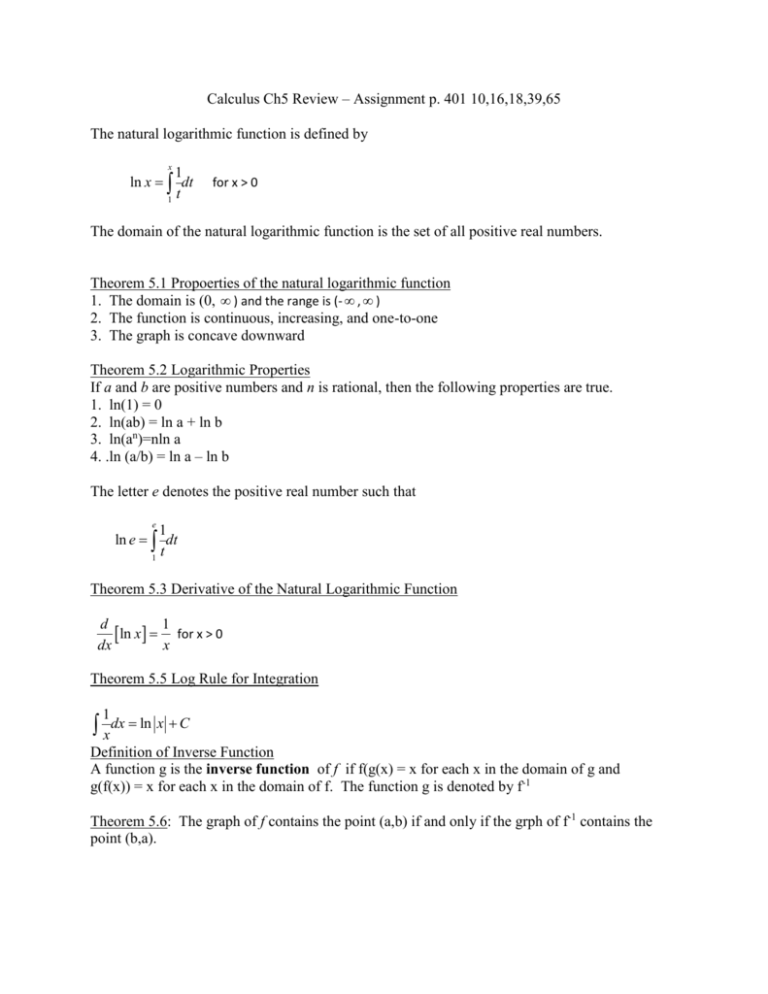
Calculus Ch5 Review – Assignment p. 401 10,16,18,39,65 The natural logarithmic function is defined by x 1 ln x dt t 1 for x > 0 The domain of the natural logarithmic function is the set of all positive real numbers. Theorem 5.1 Propoerties of the natural logarithmic function 1. The domain is (0, ) and the range is (- , ) 2. The function is continuous, increasing, and one-to-one 3. The graph is concave downward Theorem 5.2 Logarithmic Properties If a and b are positive numbers and n is rational, then the following properties are true. 1. ln(1) = 0 2. ln(ab) = ln a + ln b 3. ln(an)=nln a 4. .ln (a/b) = ln a – ln b The letter e denotes the positive real number such that e 1 ln e dt t 1 Theorem 5.3 Derivative of the Natural Logarithmic Function d 1 ln x for x > 0 dx x Theorem 5.5 Log Rule for Integration 1 xdx ln x C Definition of Inverse Function A function g is the inverse function of f if f(g(x) = x for each x in the domain of g and g(f(x)) = x for each x in the domain of f. The function g is denoted by f-1 Theorem 5.6: The graph of f contains the point (a,b) if and only if the grph of f-1 contains the point (b,a). Theorem 5.7 The Existence of an Inverse Function 1. A function has an inverse function if and only if it is one-to-one 2. If f is strictly monotonic on its entire domain, then it is one-to-one and therefore has an inverse function. Guidelines for Finding an Inverse Function 1. Use Theorem 5.7 to determine whether the function has an inverse function. 2. Interchange x and y and solve for y which is f-1(x). 3. Define the domain of f-1 as the range of f. Theorem 5.8: Let f be a function whose domain is an interval. If f has an inverse function, then the following statements are true. 1. If f is continuous on its domain, then f-1 is continuous on its domain. 2. If f is increasing on its domain, then f-1 is increasing on its domain. 3. If f is decreasing on its domain, then f-1is decreasing on its domain. 4. If f is differentiable on an interval containing c and f’(c) ≠ 0, then f-1 is differentiable at f(c). Theorem 5.9: The derivative of an inverse function Let f be a function that is differentiable on an interval. If f has an inverse function g, then g is differentiable at any x for which f’(g(x)) ≠ 0. Moreover g '( x) 1 f '( g ( x)) Definition of the Natural Exponential Function The inverse function of the natural logarithmic function f(x) = ln(x) is called the natural exponential function and is denoted by f-1(x) = ex. That is, y = ex if and only if x = ln y Properties of the Natural Exponential Function 1. The domain of f(x) = ex is (, ) and the range is (0, ) 2. The function f(x) = ex is continuous, increasing, and one-to-one on its entire domain 3. The graph of f(x) = ex is concave upward on its entire domain. 4. lim e x 0 and lim e x x x Theorem 5.11 Derivative of the natural exponential function d x e e x dx Theorem 5.12 Integration Rules for Exponential Function x x e dx e C Definition of Exponential Function to Base a If a is a positive number (a≠1) and x is any real number, then the exponential function to the base a is denoted by ax and is defined by a x e(ln a ) x If a = 1, then y = 1x = 1 is a constant function Definition of Logarithmic Function to Base a If a is a positive number (a≠1) and x is any positive real number, then the logarithmic function to the base a is denoted by 1 log a x ln x ln a Properties of Inverse Functions 1. y a x if and only if x log a y 2. a log a x x for x > 0 3. log a a x x for all x Theorem 5.13 Derivatives for Bases Other Than e Let a be a positive real number (a≠1) and let u be a differentiable function of x. 1. d a x (ln a )a x dx 2. d du a u (ln a )a u dx dx 3. d 1 log a x dx (ln a) x 4. d 1 du log a u dx (ln a)u dx Theorem 5.15 1 x 1 lim 1 lim e x x x x x x Compound Interest Formulas Let P = amount of deposit, t = number of years, A = balance after t years, r = annual interest rate (decimal form), and n = number of compounding per year. r 1. Compounded n times per year: A P 1 n 2. Compounded continuously: A Pe rt nt

